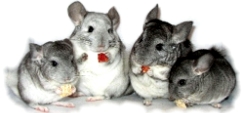
A difference, yes, but not that much difference unless there is a huge difference in the size of the chins.
Are they caged together? OR separately?
If caged together, there is no real way of telling exactly how much food and water each is getting.
I would worry more in the number of poos and the moisture and/or lack of it than the size.
A much less number of poos and/or smaller and dryer than normal, is a sign of dehydration and or a possible oncoming illness ... as a rule.
A larger, rounder and overly moist poos is a possible sign of diarrhea and the possible early signs of a different type of illness.
Their poop can tell you so much. Sounds strange ... but is very true. In the early stages of an illness or injury, a chinchilla will mask/hide the signs as much as possible, this dates back to when they lived in the wild. In the wild, any sign of weakness, illness or injury made them easy prey ... they still carry this instinct with them today. But their poop is something they can not control, so watch it for early warnings.
This is why it is important to know what each one's normal poop looks like and normal/average number of droppings there is or should be for each one.

Jo Ann
NOTE: When two or more chins are caged together you must keep a closer watch on them and on their weight ... another early sign of things to come.

 Author
Topic: poo poo size question (Read 1492 times)
Author
Topic: poo poo size question (Read 1492 times)




